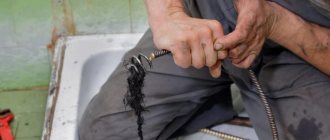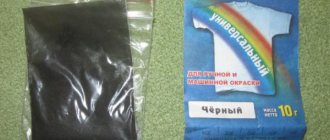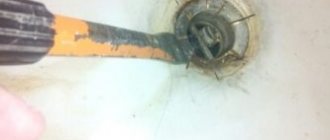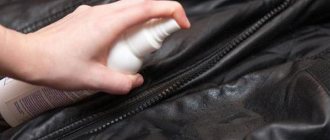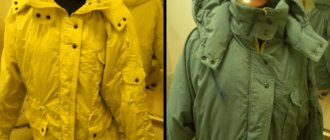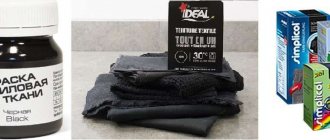The main heat-resistant paints and varnishes (paint and varnish materials) suitable for painting heated towel rails are alkyd, acrylic enamels, silicone, and water-dispersion paints. The coating must be durable, withstand high temperatures and be renewed regularly. Then the structure will last a long time, and its metal will not corrode. Below are the types of suitable paints and the features of different materials for heated towel rails. A step-by-step guide is provided on how to prepare the surface and paint it.
The heated towel rail is painted with metallic paint with a chrome plating effect Source mstal-store.ru
Selecting the right paint
In order for the new coating to last for more than one year, you need to choose a paint that would be suitable for the operating conditions of the heated towel rails. The same principle is also suitable for selecting a primer, which is used to pre-treat the surface.
Requirements for paintwork materials for heated towel rails
The paint must have the following properties:
- moisture resistance;
- wear resistance;
- resistance to friction, mechanical stress (shocks, chips, scratches);
- anti-corrosion;
- non-toxic;
- environmental safety;
- hypoallergenic.
Paint for finishing walls, ceilings or facades is not suitable for painting sanitary heating equipment in the bathroom. It quickly peels off and peels off. You need paint that can withstand high temperatures at all times. Some coil systems heat up from +120℃ to +180℃, others from +180℃ to +220℃. You need to buy paintwork materials that are designed to cover the surfaces of heating radiators and pipes of heating systems.
Types of primers
The most suitable primers for applying to the surface of a heated towel rail:
- GF-21;
- primer-enamel "NOVA and Co";
- Eckart.
Soil, like paint, must withstand high temperatures and their sudden changes. After priming, the paint coating lasts longer than when painting the surface of equipment without primer preparation.
What you need for painting
To carry out the work of painting a heated towel rail in the bathroom as quickly as possible, prepare yourself :
- sandpaper;
- flute brush (narrow and wide) or roller;
- primer;
- detergent (or solvent);
- gloves;
- putty knife;
- rags for wiping away stains;
- screwdriver or set.
Since the dryer gets very hot during operation, a special paint is required for application (standard paint for walls, floors and ceilings will not work, it quickly cracks and falls off the surface of the pipes).
For coating heating radiators and heated towel rails, the optimal choice is silky-glossy enamel, which can withstand temperatures up to 180-220 degrees.
Main types of paints (average cost 150-170 rubles per 1 liter):
- Alkyd enamel is resistant to negative influences in the form of constant temperature changes. It has an unpleasant odor, which is especially noticeable when the surface dries.
- Acrylic enamel - looks beautiful, comes in many colors, and is durable.
- Water-dispersion paint - dries quickly, absolutely safe for the human body, long service life.
The color of the enamel is chosen to match the interior and depends on individual wishes. Chrome paint for heated towel rails is very popular, adding a touch of chic to the interior. Bronze or gold shades can also be used - they look beautiful and rich.
Beautiful shades can be created using paints of greenish, bluish and beige (pink) colors.
It is not recommended to use white enamel. At first it looks beautiful, but after six months the aesthetic appeal will be lost. The pipes and heated towel rail will turn a pale yellow color due to constant temperature fluctuations.
Preliminary work and preparation of tools
You need to start painting the heated towel rail after preliminary treatment of its surface. If this is not done, the paint will quickly crack, peel off, or rust will appear through the layer, and the coating will become completely unusable.
Tools, devices, related materials
To prepare the surface of the structure and paint itself, in addition to paint and varnish, you will need:
- gloves;
- putty knife;
- wire brush or piece of sandpaper;
- Screwdriver Set;
- pliers;
- flute brush – 2 pcs. (narrow and wide);
- pile roller;
- paint sprayer (if necessary);
- adhesive primer with anti-corrosion properties;
- solvent or any detergent;
- rags.
It is best to use a brush with natural bristles. Then the application and distribution of the layer will be uniform, without streaks, omissions or unsightly streaks. Instead of a brush, you can use a roller with a coat of short pile.
If pipes need to be painted quickly and evenly, then use a pneumatic device - a paint sprayer. But in this case, you need to paint the structure before its installation, or cover all adjacent areas on the wall with a special painting film. The film must be secured well. Spray primer or paint on all sides of the heated towel rail.
But the standard way to paint heated towel rails is to remove them from the wall using screwdrivers and pliers. Then the whole process is carried out - cleaning to metal, degreasing, priming, painting, complete drying. Only after this is the structure installed back in its place by screwing the screws into their original sockets.
Before painting, it is best to remove the heated towel rail with pliers and a screwdriver Source polotentse-sushitel.ru
A heated towel rail without shut-off taps is removed with an angle grinder during the non-heating season Source remboo.ru
Preparatory work
A device such as a heated towel rail requires preliminary preparation for subsequent painting. You cannot start painting immediately without any surface treatment. Follow these steps and you will get the job done well.
- Take sandpaper and sand the entire surface of the dryer. Especially carefully clean areas where rust has appeared, the old coating has come off, the paint has cracked, or cracks have formed. Try to do the work conscientiously, since preparing the device is the most important step in terms of the final result.
- If possible, remove the entire protective layer. This will allow the new layer to lay perfectly flat and last on the device for many years. This is especially important when it comes to chrome surfaces. The enamel does not adhere well to it, so clean it thoroughly.
- After finishing cleaning, wash off any remaining particles of the coating with a wet cloth and detergent. This will not only remove any remaining dirt, but will also degrease the surface.
- The final stage of preparation is primer. Also be careful when choosing a primer. This must certainly be a primer that is intended for use at high temperatures. Nowadays, German-made alkyd primers are in particular demand. Do not apply the composition in rough layers. On the contrary, the layer should be thin and very uniform.
Now you can go about your business for a while, since the primer should dry. Once this happens, you can proceed to the next stage.
The process of painting and drying a heated towel rail in the bathroom
The paint is applied to the already dried primer. If the adhesive layer is not dry enough, then you need to wait and do not paint the surface. The mixture of paints and varnishes is thoroughly shaken or mixed gently. Some types of enamels need to be mixed in several stages, so pay attention to the consistency of the painting product. A mass well prepared for use is homogeneous, without floating oil or other liquid.
You need to apply several layers. But between them there is always a drying interval - the previous layer must be completely dry. And not touch-sensitive, but according to the instructions included with the finishing material. Approximately each layer dries and is completely hardened in 40-60 minutes.
After the heated towel rail is completely painted, it is left to dry until completely hardened for another day. There are craftsmen who recommend letting the paint dry for at least 3, 4 or 5 days. Only after this can it be used. During drying, the level of relative humidity in the room should not exceed 50-60%. Therefore, it is recommended not to use the bathtub while the paint on the equipment is drying.
Black paint was used to paint the surface of the heated towel rail Source ad-cd.net
Painting of metal, galvanized and polymer pipes
Metal pipes must first be cleaned of old paint and rust. A preliminary layer of primer is applied on top, which not only allows the top layer of paint to be well fixed, but also increases the service life of the pipes.
There should be no accumulated condensation on the pipes during the application of enamel. Galvanized pipes do not require painting . As for polymer ones, they are painted only to make changes to the interior of the room.
Plastic pipes are coated with paints that do not contain acetone or aggressive compounds such as NTs, ML.
Recommendations and useful tips
Tips for painting heated towel rails:
- When removing dirt or old paint, it is important to go especially carefully with sandpaper or a wire brush along the bends and joints with wall fasteners.
- Using a spray gun (paint sprayer) you can not only distribute the paint evenly over the surface of the entire structure, but also save money - reduce the consumption of paintwork materials.
- The best period for painting an already installed heated towel rail is any time outside the heating season. The heated towel rail cannot be painted when it is hot. The enamel simply won’t lay down evenly and won’t dry properly.
- If the enamel initially seems to be too dense in consistency, you need to dilute it with a solvent suitable for the type of paint.
- Before applying enamel, you need to make sure that there is no condensation on the pipes.
If you do not remove the entire previous layer of coating, the new paint will not adhere well or will not last long. This is especially true for old chrome coating - new paintwork materials are distributed extremely poorly over it.
Using sandpaper you can quickly clean rust from pipes Source mykrasim.ru
How to work with a chrome heated towel rail?
If a modern heated towel rail does not fit into the bathroom interior, its appearance can also be changed. Not every paintwork material is suitable for chrome: most either slip off or are quickly erased from the surface of the product. You will have to sand or sandblast it to remove the chrome plating down to bare metal. Afterwards, you can prime and paint the coil as usual.
If you don’t want to carry out such serious preparation, you can buy high-quality Tessarol or Hammerite and apply it directly to the chrome, although the price of the work will be quite high. Before painting, there is no need to sand or prime – you can simply degrease the product with any solvent.
Painting a heated towel rail is not a very difficult or tedious task; it can be done independently. A new product will last a long time if you choose high-quality paint, so there is no need to skimp on material.
Electric heated towel rail bronze
Bronze-colored electric heated towel rails mostly have the same shapes as water models. The difference lies in the method of connecting the device to the heat source and in the nature of the coolant. In electric models, antifreeze is used as a coolant, which is heated using heating elements. Electric heated towel rails create more comfortable operating conditions. They can be turned on at any time and the heating temperature can be adjusted as desired. If we conduct a comparative analysis, the advantages of electric models include:
- easy installation, no special qualifications required
- no need to obtain permission for installation from utility services
- no need to change the configuration of the heating system or the wiring diagram of the electrical network
- minimal susceptibility to internal corrosion.
The ability to move a floor-mounted heated towel rail is one of the advantages of electric models. A non-standard electric heated towel rail in bronze color is most often an individual choice of the consumer, and not a model of mass demand, since its price is twice as expensive.
When can you use the bathroom?
You can connect the freshly painted heated towel rail to other communications and start using it after the paint has completely dried. This period differs for different paintwork materials. For example, alkyd enamels require 8 to 24 hours to dry. If the enamel was diluted with solvents during the painting process, this period increases to 36 hours.
The time indicated on the packaging is calculated for an air temperature of 25°C. In residential premises it is usually slightly lower, so it is recommended to wait more than a day and only then start using the coil. Acrylic compositions are based on water, so high humidity also delays their drying.
One-component and two-component polyurethane paints based on organic solvents are usually applied in two layers and dry for about 48 hours. Water-dispersion compositions based on polyurethane used for painting plastic pipes polymerize as the water they contain evaporates. Their drying time depends on the temperature and humidity of the air. For the paint to completely cure, wait 1-2 days.
Water-based silicone paints require two-layer applications. The first layer usually takes about 3 hours to set, complete hardening occurs after 9 hours, but it is recommended to apply the second layer after 12 hours. After this, the heated towel rail is painted again and the paint is waited for about a day to completely harden. If the composition was diluted with water during the work, then polymerization will take longer than indicated in the instructions.
I hope that the material presented is enough to properly process the pipes in the bathroom on your own. A painted heated towel rail will serve for a long time and delight you with its appearance.
How to disguise a coil?
Hide coil
perhaps with the help of color, as well as the texture of the bathroom. To do this, you will need paint of the same shade that was used to paint the walls. If the color does not “get” into the desired shade, use a waterproof varnish in color.
Interesting materials:
Who are the mestizos? Who are the Nogais and where are they from? Who are the Nogais? Where did they come from? Who are the Pamirs and where did they come from? Who are the Persians? Who are the consumers in the ecosystem? What are reptiles and mammals? Who are the winners? Who are the producers in the ecosystem? Who are producers in nature?
How to prepare surfaces for painting?
The selection of a high-quality composition is very important, because it is this material that will determine the aesthetics of the result and the service life of the coating. Conventional paints and varnishes will not work: the heated towel rail regularly heats up, and they will instantly crack. When purchasing, you need to pay attention to heat resistance: the paint for a heated towel rail must withstand heating up to 120... 180 degrees.
Also, high-quality material for painting the coil should have the following properties:
- resistance to water, can be used in damp areas,
- resistance to wear, friction, mechanical stress,
- anti-corrosion properties, absence of components harmful to metal in the composition.
As for color, you should choose a tone that is suitable for a particular bathroom, corresponding to the theme and style direction. Most often, users choose paint like chrome, silver, gold, or other metallic coatings. Heated towel rails in black, dark blue, and red look original.
If desired, shades can be combined and paints mixed with each other. It is not recommended to buy only white paintwork materials - even the most resistant material will lose color and become yellowish due to temperature changes.
We suggest you familiarize yourself with How to lengthen a dress if it is short, how to alter a dress and alter the sides with your own hands
Oil paints
Such products are not suitable for working with heated surfaces. They quickly lag behind the base, have insufficient adhesion, are not heat-resistant, besides, they smell unpleasant and have a short service life.
Acrylic paints
Acrylic-based compositions do not emit harmful fumes, do not smell, thanks to their smooth texture they are applied easily and in a perfectly even layer, and do not leave streaks or drips. Acrylic paints dry quickly and have a high degree of adhesion to surfaces. They also have disadvantages: poor chemical and mechanical resistance, rapid abrasion.
Silicone coatings
These paints are based on rubber and other resins diluted with water or organic solvents. The material in the form of a suspension is durable, does not deteriorate from high temperatures, lasts a long time (up to 15 years), wear-resistant, and moisture-resistant. Solvent-based paints are especially reliable, but they emit a pungent odor until they dry.
Alkyd enamels
Paints based on glypthal or pentaphthalic varnish and special pigments are considered heat-resistant (withstand up to 180 degrees), therefore ideal for heating pipes, radiators, radiators and heated towel rails. The finished coating does not peel off for a long time, does not darken or crack.
The service life of the paintwork is at least 10 years, and the film is resistant to water, household chemicals, and mechanical factors. It is better to choose matte or silky-glossy alkyd enamels of the desired color: they look the most beautiful. These paints have only one drawback: they contain solvents, so they emit an unpleasant odor for several days.
The general rule for ferrous metal pipes is to clean the steel from rust, first coat it with a primer, then paint.
To paint metal pipes you will need:
- Tools for cleaning the pipe surface from rust and old paint: grinder, grinder, turbine, sandpaper, spatula.
- Household chemicals to prevent rust and remove its residues.
- Flute brush or roller.
- Primer for metal pipes
- Rags
- Covering material to prevent paint from getting on surrounding objects.
- Gloves.
You should not paint rusty pipes; they need to be prepared. Traces of corrosion are completely removed with a stiff wire brush or sandpaper. Phosphoric acid-based rust converters can only serve as an aid by modifying small, hard-to-reach areas of corrosion left after machining.
Old pipes and radiators are cleaned of rust, and if you want to get a neat look - also of old paint
To paint a metal pipe, you should choose primers and paints based on organic solvents. Water-soluble ones cannot be used. Among primers, the domestic GF-021 has an excellent price/quality ratio.
Instructions for primer GF-21.
We can recommend domestic oil paints, pentaphthalic paints, ours and imported alkyd paints. If a primer is available, a water-based finishing enamel can also be used. Today, manufacturers also offer universal paint compositions that simultaneously function as a primer and paint. It is more convenient to work with them, because you can paint a steel water supply or cast iron pipe in one step.
Pipes and heating radiators can be painted in any color that matches the interior design
As for heated towel rails, modern models are made of stainless steel or have a galvanic coating; only very old ones, made of ordinary metal, need to be painted.
For pipes and heating radiators, it is convenient to use this L-shaped brush with a long handle; you can use it to paint hard-to-reach places
Galvanized water pipes do not need painting, except in places where threads are cut by hand, where the coating is damaged. You cannot weld galvanized steel, but if you have already done this, the seam should also be protected.
There is no need to paint plastic pipes; they are not afraid of external influences, except perhaps ultraviolet radiation. The application of a coating can be justified by aesthetic considerations, because standard colors (white, gray, less often beige and green) will not always satisfy everyone in open areas. Manufacturers offer, as for metal, special primers for plastic.
Materials for painting plastic pipes. The best choice is any water-based compositions, including those intended for mineral surfaces: dispersed, emulsion, acrylic, organosilicon. Regular water-soluble paints for walls will wear off with constant hygienic cleaning, but there are those intended for carpentry, they are durable, easy to clean, and have good adhesion. Quite neutral acrylic and pentaphthalic ones based on white spirit are suitable.
Plastic pipes do not need painting, 90% have a standard white or gray color
We suggest you familiarize yourself with How to remove water stains in the bathroom
Painting water pipes in a bathroom or heating in a room is not difficult; you can do it yourself. Or, if an apartment or house is being renovated, entrust it to specialists; it would be better if plumbers immediately protect the metal with a primer.
Water-based acrylic compounds. In everyday life they are often called water-based paints. Materials of this group are safe for the environment, can withstand temperature changes and heating up to 90°C, and are easy to work with. Acrylic paints dry in half an hour and after drying do not stain your hands or things hung on the dryer. However, their strength is lower than that of other materials, so the coil will have to be repainted periodically. Example: enamel for radiators “Rainbow”.
Alkyd paints are also suitable for painting heating pipes. They are stronger than acrylic, so they are suitable for long-term use. Alkyd paints and varnishes contain anti-corrosion additives that provide reliable protection of metal from rust when in contact with water and steam.
The disadvantage of this type of paint is the pungent odor during painting and for the first time after it. In this regard, painting work must be done in a protective mask and with the door wide open. Then the bathroom should be thoroughly ventilated during the day. Examples: enamel for radiators “Novax”, “PF-115”, primer paint for chrome “Empire”, automotive alkyd enamels.
Silicate paints. They withstand heat and temperature fluctuations well and do not require prior application of a primer. When working with them, a strong unpleasant odor is released, so care should be taken to wear respiratory protection and ventilation. The service life of such paints is about 10 years. Example: black metal dye “Hammerite”.
Polyurethane paints and varnishes for metal. They can be clear or painted in a variety of shades, including gold, bronze and brass. They fit well even on polished or chrome-plated steel and do not require preliminary priming. Thixotropic varnishes, due to special additives, are able to change their consistency (liquefy when stirred and thicken when left alone).
Alternative finishing methods include powder coating. However, this type of work cannot be carried out independently at home, since it requires a workshop equipped with a polarizing camera. The heated towel rail is dismantled, placed in a chamber and dry pigment is sprayed onto it.
The resulting layer of paint is very durable and highly durable, so such a coil will be difficult to repaint in a different color if desired. To do this, you will have to remove not only the paint, but also the surface layer of the metal.
